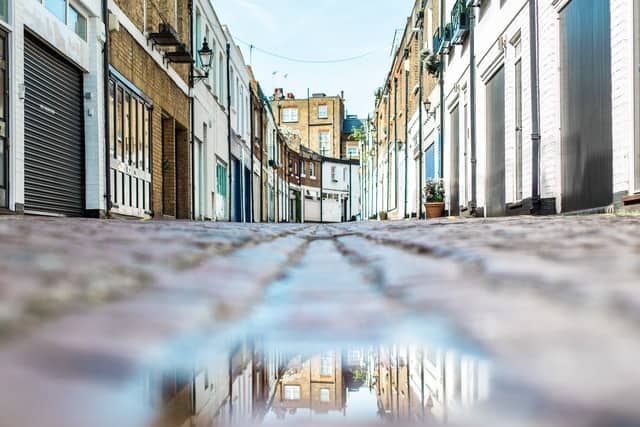
Rising damp specialists in Chelsea and Fulham
The mere thought of having damp in the home can be enough to send shivers down your spine as a homeowner, especially if you suspect that you might be dealing with rising damp. Rising damp can be one of the most problematic types of damp in the home and is caused by moisture that rises up through the walls due to water collecting in the ground underneath or next to the walls. It can happen to almost any wall including walls that are constructed from bricks, blocks, or stone. It happens as a result of capillary action, where water is sucked up through tiny holes in the wall’s construction materials, which leads to water travelling upwards through the wall until it is pulled back down by gravity. Because of this, the moisture will usually only occur on the ground floor of a property and will usually stop at around 1.2m high. However, you may notice some effects of rising damp higher up on the walls, including salt deposits, especially if your wall is covered in a non-breathable covering like vinyl wallpaper or washable paint.
Signs You Need Rising Damp Specialists in Chelsea
There are some common signs to look out for in your Chelsea home that could indicate a problem with rising damp. One of the most typical signs to keep your eye out for is a ‘tide line’ of discoloured brown or yellow staining of the plaster occurring on the ground floor, on the lower area of the walls just above the skirting boards. Rising damp can also have an effect on your skirting board woodwork, and you may notice that it feels damp to the touch or even that there are visual signs of rotting. The damp and moisture in the wall can cause salt deposits to be washed out of the bricks and into the plaster, which you may notice higher up than the damp itself, depending on the type of wall coverings that you use. After some time, rising damp can also lead to mould developing on the walls, which appears as black spots.
Reasons to Hire Rising Damp Specialists Fulham
If you have noticed any of the signs of rising damp in your Chelsea or Fulham home, then it’s important that they do not go ignored. This is because rising damp in the property is often a sign of a bigger problem with your damp proof course. The damp proof course is a water-resistant layer that is installed at ground level and spans the width and length of your property’s walls. Its main purpose is to prevent moisture from the ground reaching the walls and causing rising damp. Because of this, any issues with rising damp in the home are almost always an indication that something has gone wrong with the damp proof course, and this is a problem that will need to be repaired by a professional.
Rising damp often means that rather than being drained away from your property, the moisture is being drained towards it – and this isn’t going to go away on its own until the damp proof course problems have been dealt with. Along with being an unsightly problem for your home, the potential health issues that rising damp can cause are another reason why you should never ignore it. Spores from the mould that rising damp can cause over time can lead to various health issues including respiratory problems, which can be very dangerous, especially for people in the home who already suffer from allergies or asthma.
What Causes Rising Damp?
Rising damp problems are almost always a result of issues with the property’s damp proof course. This could include no damp proof course being present, which might be an issue if you have an older property that was built before a damp proof course in new properties became a mandatory building regulation in the early 1900s. Thankfully, this is quite a rare issue since most properties in the UK have had a damp proof course installed regardless of their age. However, if your property’s damp proof course was installed a long time ago, then general wear, tear, and deterioration over time may be causing it to not work as effectively as it should.
When the damp proof course begins to lose its water-resistant properties, this can make it easier for the moisture to travel upwards and through the damp proof course into the walls, causing rising damp. However, ‘bridging’ of the damp proof course is the most common reason why rising damp occurs in properties. The good news is that this does not indicate that there is an issue with the damp proof course itself. In fact, the damp proof course may be working perfectly and doing its job effectively, however, something is creating a ‘bridge’ for the moisture to get over and above the damp proof course where it will penetrate the walls and cause rising damp.
This can be caused by several things including structures or objects close to the external walls, debris blockages inside the cavity walls, or even if your neighbour’s damp proof course on an adjoining wall is not installed at the same height as yours.
How to Be Sure You’re Dealing With Rising Damp
Since rising damp is a commonly misdiagnosed damp issue in homes, it’s important to be sure that this is the issue you are dealing with if you have noticed some of the common signs. While rising damp will only occur on the ground floor of a property and will not usually exceed more than 1.2m in height, it can be easy to mistake penetrating damp or damp from condensation as rising damp if it occurs in the same place. Because of this, it’s best to have your property inspected by a professional who can check the damp proof course to determine whether it is rising damp or another type of damp that you are dealing with.
How to Determine What’s Causing Rising Damp
Rising damp is almost always due to an issue with the damp proof course, but the exact cause might not always be obvious to an untrained eye. Because of this, the best course of action is to have a damp proof specialist inspect your property to get to the bottom of the cause, and make sure that it is actually rising damp that you have noticed.
The first thing that they will do is inspect the damp proof course to first check that there is one present at the property and secondly to inspect it for any kind of failure or ineffectiveness. The specialist will also look for any signs that the damp proof course has been breached or bridged, allowing moisture to get over it or around it. If you are not sure whether or not there is a damp proof course at your property, this is usually something that you can easily check yourself.
You should see a visible line on the exterior of your property that is usually located around six inches above the ground level. It is also worth asking your neighbours about their damp proof course since even if yours is working and functioning as it should, rising damp could be getting in from an adjoining property if your neighbours do not have a damp proof course, their damp proof course has failed, or if the damp proof course in the next property is installed higher up than yours is. This allows the moisture to travel around your home’s damp proof course and leads to rising damp.
Treatments Available for Rising Damp
How you decide to treat the rising damp in your home will depend on what has caused it. Simply dealing with the effects of rising damp such as wet patches on the wall or musty smells might hide the issue for a while but it is only likely to return if you don’t get to the root of the problem. It’s always best to hire a damp specialist to deal with the underlying cause of the rising damp before you carry out any cosmetic work to hide the effects of it indoors. Repointing, applying damp proofing undercoat to the walls, or repainting might mask the issue for a while, but it is only going to get worse and reappear over time if your damp proof course has failed or if it is bridged. Over the long term, this is only going to mean more work and more money spent.
When rising damp is caused by a bridge to the damp proof course such as a blockage in the cavity wall or high outdoor ground that is allowing moisture to get over the damp proof course, removing the source of the bridge is usually the best course of action. If your damp proof course has failed, or there is no damp proof course present, a new one will be installed. This is done by injecting moisture-repellent chemicals into the bricks.
Rising damp can be a serious issue in your home that can lead to various problems if left unchecked. If you suspect that your property might have rising damp, contact a specialist as soon as possible.

